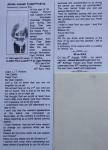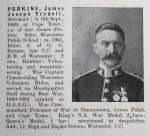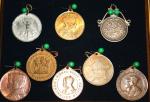-
Posts
13,225 -
Joined
-
Last visited
-
Days Won
22
Content Type
Profiles
Forums
Blogs
Gallery
Events
Store
Everything posted by Mervyn Mitton
-
Hi, Will and Hello, Ian. I'm sure I posted a reply to this plate and Will replied, as I was going to give him the Chairman of Police Insignia's Collectors Association contact details. I wonder what happened ? We have an internet problem in S.A. at present - the main cable has parted and they are trying to repair. Surely the message wasn't deleted because I mentioned another Group ? This helmet plate is a Night Plate and was worn - on a separate helmet for night patrols - the chromed plates reflected light very badly. As Ian says - 'B' Division - which is Knightsbridge , the area surrounding Harrods. The number was individual to the Constable and at that time was worn on either side of the tunic collar. *** Mystery Solved. You had it posted on both Police sub-forums and I had replied to the World one. Hope I said the same on both.................
-
Hi - 1314 - that is comprehensive info. of the first order. Nick is very fortunate. Are you ex-HK Police - they were a very fine Force in the true background of our Colonial Service Police. The British South Africa Police in Rhodesia were always held up as being the top one - but, to my mind they were both fine units with exceptional standards. I was actually considering joining the HKP in the 1960's - but decided on the Met. since we started it all... Nick - you're older than I am !!! Would be interesting to see some of your Father's early equipment and paperwork. The rank of stripes - surmounted by a Crown , was originally a Station Sergeant. The Sgt. who actually ran the Police Station. I think it was in 1970 that the rank was abolished and all holders were promoted to Inspector. I suppose the nearest Army equivalent would be a CSM - certainly, you treated them with respect - they were mostly older service police officers.
-

VICTORIA CROSS 'MYSTERY'
Mervyn Mitton replied to Mervyn Mitton's topic in Great Britain: Orders, Gallantry, Campaign Medals
Stefan -Hi. That is very interesting information and explains a lot about what happened to his 'grave'. We call this type of burial - a 'paupers grave' - very sad that it should have happened to a man who won the World's highest Valour award. -

HELP Identify Police Helmet Plate
Mervyn Mitton replied to Will M's topic in Police Forces of the World
Will - welcome to GMIC. The Helmet Plate is for the London Metropolitan Police - it is a night plate, intended to be worn on a separate helmet and at night will not reflect light and so, give the constable's position away. The 'M' is for M Division - which is South of the River Thames - I can't remember it's exact boundaries, however, I'm sure someone will help us. The number is the officer's and would be worn -at this time - on either side of the collar. Crown is George 5th or, George 6th. Remember , that all civilian policing - as we know it - started with the Metropolitan Police in 1829. The Chairman of the Police Insignia Collectors Association is looking for an 'M' Division night plate - if you are thinking of selling, I will put you in touch with him. Mervyn -
-
Apart from being C.O. of the Worcester Rifles Volunteers - during the Boer War he was taken onto the Staff of Cape Command and had the posting of an Asst. Adjutant General. More importantly, he was the overall commander of the Prisoner of War camps in Capetown. There were several in the area - however, the main was at Greenpoint - where they have just built the new football stadium. He also had jurisdiction over the holding camp at Simonstown. This has always been our main Naval Base and his job was the handing over of P.O.W.'s for transportation by the British Navy to the four main centres we had set-up prison camps. These were India - Ceylon (now Sri Lanka) - St. Helena and Bermuda. With these responsibilities I am surprised he was only a captain.
-
It is very interesting that the maker's details are another contractor - this time from Capetown. Perhaps Jonathan can help with the original maker - strange though that the last two English swords have had local suppliers names. I know nothing about the firm of Mitchell - however, the relative of the Jo'burg company thought that they had supplied all swords to the S.A. Forces.
-
-
Captain Perkins was the Commanding Officer of the Worcester Rifle Volunteers. This unit was formed in the late 1850's and had a compliment of 58 men. This later grew as the area had more settlers. This Worcester is in South Africa and about 40 miles inland from Capetown. All of these early towns had their own defence units.
-
-
When I recently posted on 'British and Commonwealth Medals' the Boer War medals and other personal items from Captain Perkins, I only showed two pictures of his sword and did say I would post them more fully on this sub-forum. The 1827 Rifles pattern sword was based on the Infantry pattern - however, on the guard it remained as a solid piece and the inner section did not fold flat as with the Infantry officers'. The other main difference was also on the guard. In the cartouche , rather than the Royal Arms the Light Infantry 'strung bugle' was used. The Crown on the sword illustrated is almost certainly the pattern for King William 1V th. (1830-37) - what I am not sure about , is if this Crown continued to be used as part of the original pattern - Queen Victoria had several different Crown styles during her Reign and it was never quite as angular as this one. The sword is in excellent condition and unusually has the dress scabbard and the field service pattern scabbard. The frog for this is Boer War and has more leather support then on the 1st World War ones. Captain Perkins swagger stick is also shown. When I show his portrait you will see that he is wearing this sword . Dress swords are worn at the 'trail' and can be attached as shown or, had two clasps - one longer than the other - to suspend from the dress belt.
-
Do other Countries produce this multitude of Medallions ? From top left : 1910 Aluminium disc, to commemorate the Union of South Africa ; 1936 intended for Edward 8th. Coronation ; the Natal Medallion for Edward 7 th's Coronation. Large one for Chiefs, Middle size for Mayors etc., small one (shown here) for hand-outs. Has the two running Wildebeeste. which are part of the arms of Natal. From bottom left : 1935 silver Jubilee for George 5th. ; front and back of medallion to commemorate the 1947 Royal Visit ; 1961 Sth. Africa became a Republic ; 1937 Coronation of George 6 th.. I always think medallions tend to be overlooked in favour of medals ?
-

Some killer photos.....
Mervyn Mitton replied to Chris Boonzaier's topic in Great Britain: Research, Documentation & History
Leigh - a very valid point if they were of the same battle - or subject. These seem to be of a variety of incidents and units and therefore, could be in their own groups. I will always be in agreement for things that should remain as a whole. -

Some killer photos.....
Mervyn Mitton replied to Chris Boonzaier's topic in Great Britain: Research, Documentation & History
Chris - I think you are wise not to post more of these - the ownership/copyright can quickly be lost with things on the internet. These are some of the best photos I have seen from the conflict and their condition - in most cases clear and sharp. Several will be more valuable then the others - but - unless from originals already known about , they will seriously be in demand for book illustrations and TV programmes. They will just need to be marketed in the right way. Now that I have seen them, I would recommend that you split into mixed groups of ten or, fifteen. ChrisLiontas asks a valid question about why the Boer War is important. Quite simply it was not a conflict - but a War that came to involve most of the major countries. For the first time Britain found herself fighting in a style far outside the experience of most of the Generals -we had to learn commando tactics, trench warfare and how to move quickly over , literally thousands of miles. Much of this experience was directly used in the 1st World War. Nearly all of our Dominions and Colonies contributed men and supplies - and again the lessons learned were put to good use in WW1. Eventually, over 750,000 men took part on the British side during the 4 years of the conflict. -
Hi - Ed.Hope all is well. This combination of hat and badge must be quite rare ? Is the hat the same pattern that State Troopers wear. Very nice quality on both pieces.
-
Nick - I would think two possible reasons. Malta was very much under the control of the Navy and Army at that point and the Police probably came under their jurisdiction. Which leads to the second point - they may have supplied the helmet from stores. But - as always, we will probably learn a different reason...
-
The first ones had great quality - the last one looks really 'cheap'. Very interesting topic - I had no idea there were so many variations.















